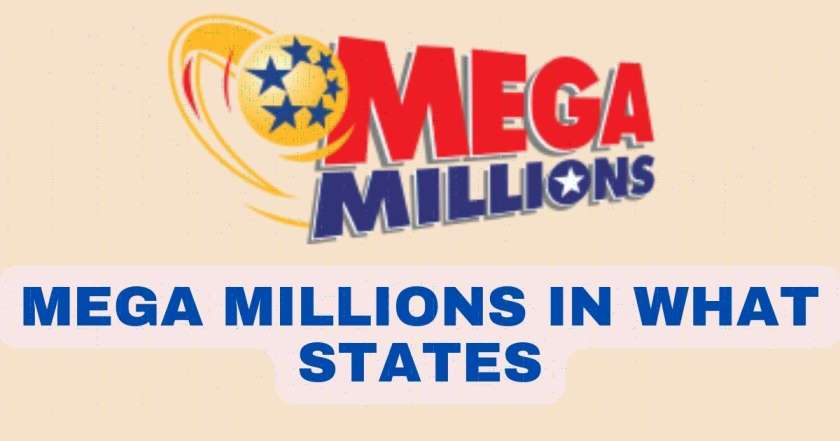Mega Millions in What States
Mega Millions is played in 45 states, the District of Columbia, and the U.S. Virgin Islands.
Here is the list of states where Mega Millions is available:

Mega Millions in USA
In the United States, Mega Millions is one of the most well-known and often played multi-state lotteries. It is available in 45 states, the District of Columbia, and the U.S. Virgin Islands and is run by the Multi-State Lottery Association (MUSL). Due to the game’s enormous payouts and the excitement it causes among players wanting to become millionaires overnight, it has become extremely popular.
When purchasing Mega Millions tickets from authorized lottery retailers, players select five main numbers from a pool that normally ranges from 1 to 70 and one extra number, the “Mega Ball,” from a secondary pool that typically ranges from 1 to 25. The Mega Ball and the five major numbers are drawn at random during the designated times for the drawings.
To win the jackpot, you must match the Mega Ball and all five major numbers. If there are several jackpot winners, the money is split equally between them. Additionally, Mega Millions includes a number of other prize categories for matching only a portion of the numbers, giving players more chances to win smaller prizes.
Mega Millions has developed into an iconic lottery game thanks to its sizable jackpots, ease of accessibility, and the thrill of winning life-changing prizes. Mega Millions has captured the attention of millions of players and made a significant contribution to numerous charitable causes because a portion of ticket sales is frequently used to fund state programmes and initiatives.
Which US States doesn’t participate in Mega Millions
There are five U.S. states that did not participate in the Mega Millions lottery. These states do not offer Mega Millions tickets for purchase:
- Alabama
- Alaska
- Hawaii
- Nevada
- Utah
History of Mega Millions
Mega Millions has two distinct lottery games in its past: “The Big Game” and “The Big Game Mega Millions.”
Six states—Georgia, Illinois, Maryland, Massachusetts, Michigan, and Virginia—launched “The Big Game” in 1996. The development of a massive multi-state lottery game was a groundbreaking endeavour. As more governments joined the consortium over time, it became increasingly alluring to participants.
To reflect its greater payouts and set it apart from another game with the same name named “The Big Game” in another region, the game was relaunched as “The Big Game Mega Millions” in 2002. Ohio and New York joined the consortium the same year, extending its reach even further.
The game was finally given the name it is known by today, “Mega Millions,” in 2010. The game eventually included 45 states, the District of Columbia, and the U.S. Virgin Islands due to the incorporation of more states under this new name.
Mega Millions has set records throughout its existence with its enormous prizes, capturing the country and drawing a sizable number of players expecting to win life-changing sums. The game offers players the option to dream big and help various state programmes and beneficiaries with their ticket sales, and it has grown to be a significant cultural phenomenon in the United States.
Gameplay and Odds of Mega Millions
In the multi-state lottery game Mega Millions, players choose five main numbers from a pool of generally 1 to 70 and one extra number, the Mega Ball, from a different pool of often 1 to 25. Participants may buy tickets from authorised lottery dealers in the participating states to participate.
In order to play, players must select their numbers and wait for the regularly scheduled drawings, which take place twice a week. The Mega Ball and the five primary numbers are picked at random during the drawing. The final objective is to match the Mega Ball with all five major numbers to win the jackpot.
Depending on the prize tier, different odds exist for winning the Mega Millions. Matching all six numbers increases your chances of winning the jackpot, but the odds are normally 1 in tens of millions to hundreds of millions. The odds of matching a smaller set of numbers, such as two major numbers or one main number and the Mega Ball, are higher for lower reward tiers.
The draw of Mega Millions rests in its enormous prizes, which frequently reach hundreds of millions or even billions of dollars, as well as the thrill of the chance of becoming an instant multimillionaire with a single ticket, despite the long odds of winning the jackpot.
Record-Breaking Jackpots:
With constantly record-breaking payouts, the Mega Millions lottery has captured the nation’s attention and encouraged people to dream big. In 2012, the Mega Millions lottery made history when three fortunate winners shared a massive $656 million jackpot, which at the time was the largest payout in lottery history.
Since then, Mega Millions jackpots have increased dramatically, including the infamous $1.537 billion reward won in 2018 by a single ticket holder in South Carolina, which broke the previous record for the biggest lottery payout ever won by a single ticket. These enormous jackpots generate a great deal of excitement, which results in huge lines of eager players and dominates news stories around the country.







